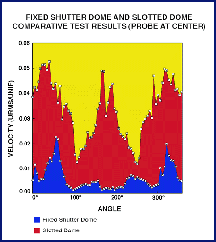
NASA Ames Research Center's Wind Tunnel Test of the Fixed Shutter Dome (FSD) was obtained through the Commercial Programs Office, and granted by NASA in support of their research objectives. The tests were run by Gregory G. Zilliac in the 48" x 32" wind tunnel at the Fluid Mechanics Laboratory under the direction of Dr. Sanford S. Davis.
 |
|
MONOPTEC
provided four acrylic models for the tests. Three had circular
openings, at (in degrees) 0, 30, and 60 zenith angles. As a control,
a fourth model had a slot from zenith to 60 degrees, to model
a conventional slotted dome. The opening widths were limited to
40% of the dome diameter. While the FSD can easily accomodate
openings to 50% of overall diameter, the slotted sphere would
not have been realistic at such a large opening width.
The
undesireable effects of the wind on the image quality obtained
at astronomical facilities can be manifested in several ways.
First, the image can vibrate as a result of wind shaking the telescope
structure. Second, image spread occurs when the mirror-to-air
interface is not in thermal librium. Last, optical wave front
distortions cause image spread at the dome interior-to-exterior
air interface as a result of temperature gradients. |
All Rights Reserved Copyright © MONOPTEC - 2013